West Nile Virus Outbreaks, 1937 - 2002
Installed on 21 August 2002. - Latest Update 07 Apr 2019.
New or revised text is in bold.
The purpose of this web page is to collate data and news items pertaining to West Nile Virus (WNV) and to examine the correlation (or non-correlation) between Venus inferior conjunctions with Earth and documented initial cases of new West Nile Virus outbreaks.
life on venus, origin of west nile virus
24 September 2002
Link to an article on WNV vs HIV to go here.
The null hypothesis in this paper is that there is no significant correlation between whatever Venus does and new outbreaks (of unknown origin) of West Nile Virus. The metric being used is the time differential between Venus inferior conjunctions and initial cases of West Nile Virus in geographical regions where transmission of the disease from other terrestrial regions is in question.
The author is, of course, actually looking for evidence to support the opposite-hypothesis, i.e., that truly new outbreaks of West Nile Virus (as part of a broad spectrum of viruses and/or bacteria, which are transported from Venus to Earth by the solar wind) will usually manifest themselves 30 to 60 days following Venus Inferior conjunctions. The stated period includes one or two days to make the interplanetary trip and the rest of the time is required to for the microbes to filter down to Earth's biosphere.
Symptoms of West Nile virus
First Recorded Study of West Nile Virus - 1937
Unless new information comes to light, the first case of West Nile virus to be subjected to scientific study was brought to medical attention in December 1937 at Omugo (Omogo), West Nile district, Northern Province of Uganda. That case (and the subsequent viral characterization process) was documented by members of the Yellow Fever Research Institute, Entebbe, Uganda in 1940.(1)
The researchers provided no information as to when people or animals in the area first began to have symptoms of what they came to call West Nile virus. They did report: "The sera of five individuals, exclusive of the source of the virus, residing in the West Nile district were tested and one was found to contain virus-neutralizing antibodies, indicating that immunity to the virus is probably not uncommon in that area." p. 486, ref (1).
In light of the Venus origin idea about viral and bacterial life forms being promoted in this collection of articles, the following statement by the researchers, about West Nile virus, might come to be of particular interest.
"The acidophilic degeneration of nerve cells in the cerebrum and of the Purkinje cells induced by the West Nile virus would appear to be a unique and distinguishing feature. p. 491, ref (1). (Emphasis added.)
Unless otherwise advised, this writer interprets the use of the word acidophilic as implying that the West Nile virus causes the production of acids harmful to its host, which may imply that it thrives in acidic environments. (Modified 15 Sep 2002.)
The writer has been otherwise advised. A correspondent has furnished the following info.
FYI: "acidophilic" and "basophilic" is an older term that was used generally to
describe how [things inside] cells took up stains, ie., DNA, being acid, was
basophilic (as I recall), taking up basic dyes, whereas most cytoplasm I think was
basic in nature and took up acidic stains. ... It has more to do with cell
chemistry than outside matters.
(Thanks to M.W. MacGown of Chattanooga, TN. 13 September 2002)
Whatever the specific meaning is for acidophilic degeneration, as used in the referenced paper, a question of importance to this current research is when, year and month, did this unique form of degeneration first become evident? Going perhaps a little further back. When were cases of the new illness first symptomatically differentiated from Yellow Fever?
Although there is currently no vaccination or known cure for WNV, it may be of interest to note that the original researchers (in 1938-1940) found that guinea pigs appeared to be immune to WNV and that guinea pig serum (for the ones they had at their research station) was toxic to the virus. Ref (1) p. 480.
Shown here is a summary of information (found to date) on WNV outbreaks. The delays (in days) between the Venus inferior conjunctions and the outbreaks are included. Approximate dates are marked with tilde's (~). As better data comes in, the table and it's associated histogram will be updated. First cases in given countries are shown in bold.
(I) (II) (III)
Year Location Type Venus Inferior Dates of Intervals
Conjunctions Onsets (Days)
1937 Uganda Human 18 Apr 1937 <15 Dec 1937 <244
1951 Israel Human 03 Sep 1951 ~15 Jul 1951 -150
1954 Israel Human 15 Nov 1954 ~15 Jul 1954 -122
1996 Romania Human 11 Jun 1996 15 Jul 1966 34
1998 Italy Horses 17 Jan 1998 20 Aug 1998 215
1999 USA Birds 27 Aug 1999 29 Jun 1999 -54#
2000 Israel Human 30 Mar 2001 16 Jul 2000 -257
2001 Israel Human 30 Mar 2001 16 Jul 2001 107
2001 USA Birds 30 Mar 2001 04 May 2001 35
2002 Israel Human 03 Nov 2002 16 Jul 2002 -110
The following graph shows the timing of first detections of West Nile virus in each country with respect to the 584 day Venus-Earth synodic period. Inferior conjunctions correspond to the horizontal midpoint of the graph. Onsets depicted on the left hand side preceded conjunctions. Those on the right hand side followed the conjunctions. (WNV outbreaks in later years, for a given locale, are not included in the graph.)
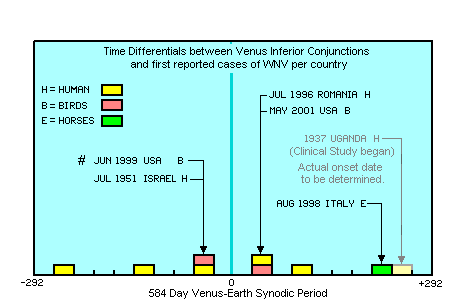
The 1937 Uganda WNV study, which started sometime in December that year, is not considered by this writer to be an onset event. With that in mind, it would not be proper to use it for conjunction to onset statistics. It is shown on the graph in a faded out fashion as a reference point.
Other WNV outbreaks to be considered for display above, include, but are not limited to, Egypt and France (1960), South Africa (1974). Reader assistance is solicited for leads to the data. (E-mail address is at bottom of article.)
The 1998 outbreak in Italy is described in G.L. Autorino, et al, West Nile virus Epidemic in Horses, Tuscany Region, Italy, CDC Emerging Infectious Diseases, Vol. 8, No. 12, Dec 2002. [Added 21 Aug 2011.]
Information on Outbreaks Since 1937
There is a comprehensive historical study of WNV outbreaks in Europe(4), but onset dates are not given. WNV events in each country are generally given by the years in which they occurred. The bibliography of this document is being used to find original published sources in order to get the onset dates.
1951 - Israel
July-August - Galil - Hadera area (N and NW part of Israel).
(Israel Ministry of Health: preliminary info.) [Since a firm onset date is not presently
known by this writer, July 15th will be used.]
1954 - Israel
July-August - Galil - Hadera area (N and NW part of Israel). (Israel Ministry of Health
preliminary info.) This outbreak was in the same area and same time of year as in the
1951 outbreak. These factors seem to indicate a terrestrial source in this case.
1996 - Romania
West Nile encephalitis epidemic in southeastern Romania (2)
Between July 15 and October 12, 1996, 393 [human] patients were identified with serologically confirmed or probable WNF infection, of whom 352 had acute central-nervous-system infections. Report was by members of the Division of
Vectorborne Infectious Diseases, Centers for Disease Control and Prevention,
Fort Collins, CO, USA.
[July 15, 1996 was 34 days following the June 11 Venus inferior conjunction. There may have been earlier cases, but that info has not been found by this writer yet.]
Viral meningitis in Romania - Update 3: 24 September 1966 -
http://www.who.int/disease-outbreak-news/n1996/sept/n24sep1996.html -
[Link no longer works.]
As of 23 September, a total of 450 cases of viral meningitis had been
reported in the outbreak which started in Bucharest at the end of July.
...The WHO Collaborating Centre for Reference and Research on Arboviruses
and Haemorrhagic Fevers at Pasteur Institute, Paris, France has confirmed
infection with West Nile virus in 89% of the patients investigated with very
high levels of IgM antibody... Infection with West Nile virus can be
asymptomatic or cause an influenza-like illness. Severe manifestations
include meningitis and meningoencephalitis... Source: WHO/OMS Communicable
Disease Surveillance and Response (CSR) report.
1999 - United States
The first case of West Nile virus in the Western hemisphere has been
reported to have occurred in New York City (two dead crows) on June 29,
1999. The onset may have been about two weeks earlier. According to
a U.S. Government Accounting Office report(3), a veterinarian at Bayside
veterinary clinic (New York City area?) found crows with signs of
nervous system disorders in the mid-June to late July 1999 time frame.
The birds were treated. Those that survived were released.
Based on the idea that new batches of WNV come to us from Venus, and that our aerobiological "delivery system" most likely behaves in a sporadic fashion, it is postulated that there should have been cases of WNV in geographical pockets around the country at the same time that the eastern seaboard events occurred. (Human population densities in the region of New York City (and surrounding urban areas) would tend to make discovery and reporting of WNV more probable than in less-dense countrywide environs.) Sudden cases of encephalitis, meningitis, and/or poliolike symptoms (of unknown origin) that occurred in the July through October 1999 time frame should be candidates for after-the-fact serological WNV investigations. (The author is aware of two such cases in his northeast Mississippi home town, population 35,000.) Consideration of this matter should not be limited to the United States. [Added 29 September 2002.]
2000 - Israel
16 July - First Human cases.
2001 - Israel
16 July - First Human cases.
2002 - Israel
16 July - First Human cases.
Special Problem
(Added some time in September 2002)
If one chooses to think in terms of extraterrestrial pathogens entering Earth's upper atmosphere one to two months prior to their expression at the Earth's surface, then the upper atmosphere drop-in time frame (for the June 29, 1999 USA WNV bird deaths) would have been roughly April 29 to May 29. In the middle of that period, the angle between Venus and Earth, with respect to the sun, would have been on the order of 70 degrees. At that angle the solar wind should have blown Venusian particles, biological or otherwise, well clear of the Earth. See diagram (A) This looks like trouble for the Venusian pathogen hypothesis.
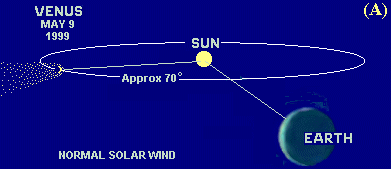
Venus-Sun-Earth angle approx 70 degrees - Normal solar wind.
Bad stuff is "blown away."
On the other hand.... (Read: Save the Principle!)
An unprecedented solar wind disruption took place on May 10, 1999, which may have some bearing on the interplanetary particle delivery problem. From late May 10 to early May 12, NASA's ACE and Wind spacecraft observed that the density of the solar wind dropped by more than 98 percent. See NASA's article: The Day the Solar Wind Disappeared.
This writer speculates that the unusually intense Gamma-Ray Burst (GRB 990510), which was also detected on May 10, 1999, at about 8:49 universal time (UT), caused the solar wind disruption just mentioned.
The effects of the GRB should have been at least two-fold. Keep in mind that the GRB radiation roared through the solar system from a point near the South celestial pole, and that most of the material density associated with the solar wind is concentrated near the solar system's equatorial plane. (Click here to see a graph of Ulysses spacecraft data regarding solar wind density and speed as functions of heliographic latitude.)
I suggest that that the majority of all exposed solar wind atomic
nuclei, those more massive than hydrogen (H1), would tend to have been
photodissociated (all the way down to protons and electrons) by the
Gamma radiation.
[The word "disassembled" was replaced by "photodissociated" on 25 November
2004.]
[See: GRB 990510 and a Solar Wind Problem for further details, including the rest of the story about the Gamma induced photodissociation of massive nuclei.
The NASA article, referenced above, described a paucity of heavier ions in the solar wind. (Time frame not stated.) "According to observations from the ACE spacecraft, the density of helium dropped to less that 0.1% of its normal value, and heavier ions, held back by the Sun's gravity, apparently could not escape the Sun at all.") That reads as though the Sun's solar wind propulsion mechanism must have temporarily lost its ability to accelerate the heavier ions to their escape speeds. (There may be a problem with that line of reasoning.) For the average solar wind speed, which is on the order of 400 kilometers per second, it takes 4.3 days for ions to travel from Sun to Earth. If the sun had lost its acceleration vigor, so to speak, at the same time as the wind density began decreasing, we wouldn't have known about it until about four days later.
[This last sentence is not stated correctly. What should have been said is: "If the sun had lost its acceleration vigor, so to speak, at the same time as the wind density began decreasing, there should have been some remarkable corresponding optical or electromagnetic perturbation in the Sun's appearance starting four to five days prior to May 10th." RSF 7 July 2003]
If the GRB unwound the heavier nuclei, then the deed should have been accomplished within a fraction of a second* whenever/wherever the radiation passed through a given volume of space. Instant plasma puree! Comparison of various spacecraft data has probably already resolved that question. *GRB 990510 had a complex light curve which lasted approximately 105 seconds.
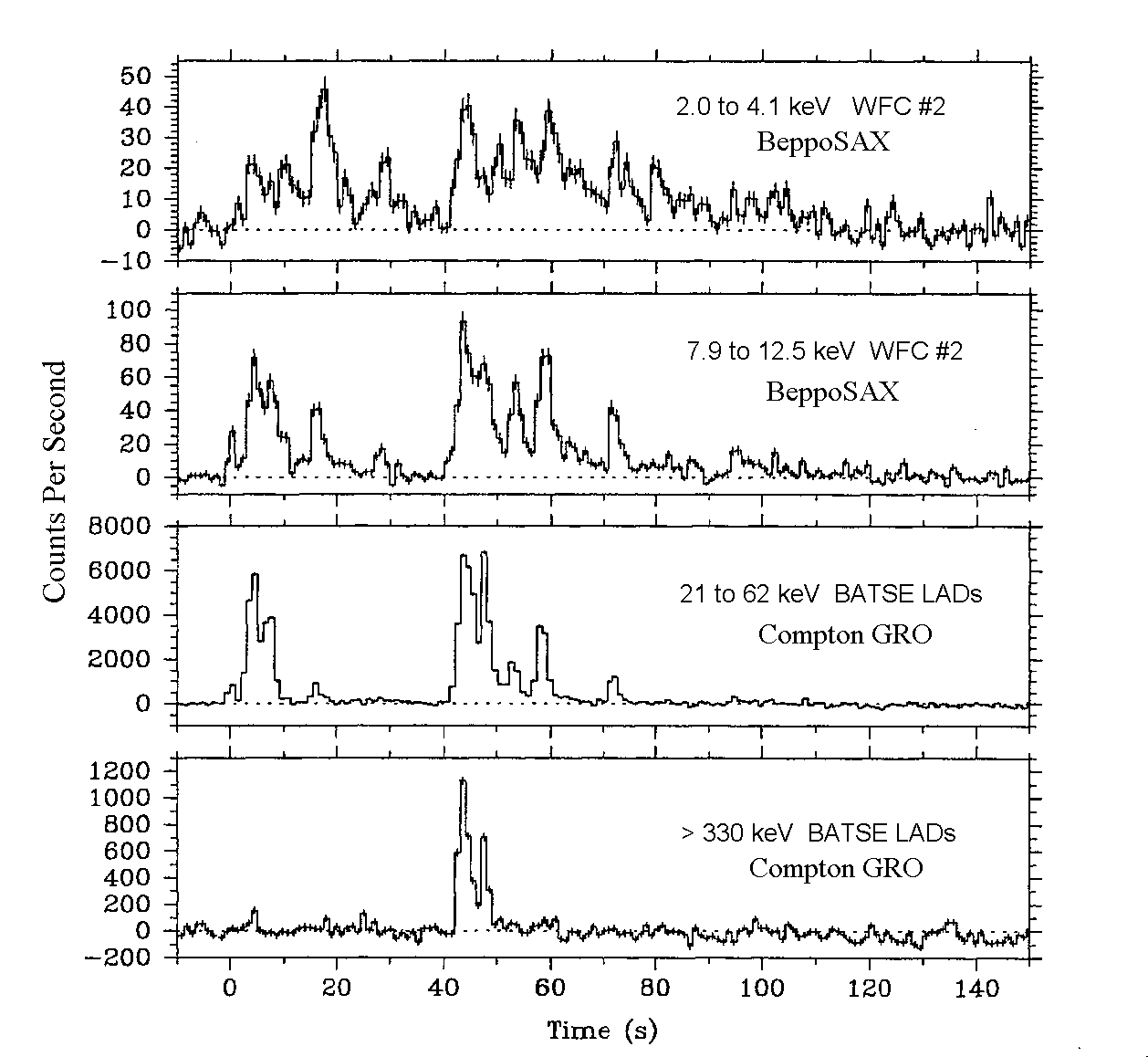 Source: Wide-Band Specroscopy of GRB 990510, Michael S. Briggs, Robert D. Preece,
Source: Wide-Band Specroscopy of GRB 990510, Michael S. Briggs, Robert D. Preece, Jan van Paradijs, Jean in 't Zand, John Heise, Erik Kuulkers and C. Kouveliotou
Gamma Ray Bursts - 5th Huntsville Symposium Huntsville, Alabama, pp 125-129. Fig 1, page 127.
My interpretation of the fourth light curve is that most of the highest energy in the first spike was dissipated in the solar wind photodissociation process. [Added 6 Apr 2019.]
For info on GRB 990510 see the European Southern Observatory (ESO) press release
Southern Fireworks above
ESO Telescopes, 18 May 1999, and the South African Astronomical Observatory
(SAAO) press release
The Light of 5 Billion Billion Suns, 19 May 1999.
URL was http://www.saao.ac.za/no_cache/public-info/news/news/article/117/615/neste/30/?tx_ttnews[pS]=1128161770&cHash=10861ca44e83dd3b311b3df2966db471
To see a currently unorthodox hypothesis on Gamma-ray Bursts, go to Ritzian Gamma-ray Bursts.
Regardless of what caused the solar wind interruption, it could be useful to determine whether or not the two-day cessation could have permitted Venusian particles to jaywalk, so to speak, to Earth, as depicted in diagram (B).
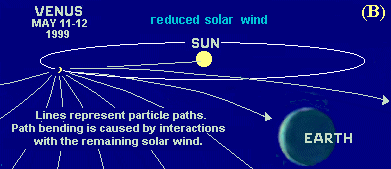
Solar wind reduction allows jaywalker event?
The present delivery mechanism under consideration is that Venus, as an electrically charged sphere, accelerated charged microscopic particles (including microbes) in its upper atmosphere, sufficiently for them to make the roughly 100 million mile journey to earth before the solar wind disk regained it's normal density and speed. For this transfer to work, as stated, the viral particles would have to be traveling away from Venus at approximately twice the average speed of the typical solar wind. [This paragraph was revised on 7 June 2009.]
Any jaywalking Venus viruses that reached Earth's upper atmosphere on around May 13, 1999 could conceivably have been doing their thing, i.e., initial outbreaks, in the time frame of June 13 to July 13. That's using the one to two months window mentioned above. The first reported cases of crows with nervous disorders (birds usually get it first) occurred in mid-June.
Diagram (C) shows the normal hypothetical delivery geometry for Venusian particles to Earth. (In this case the August 22, 1999 Venus inferior conjunction is being shown.)
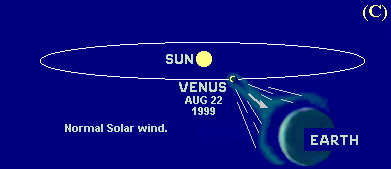
Normal Venus-to-Earth Delivery System
The normal one-month minimum-delay, between Venus inferior conjunctions and associated disease outbreaks, (associated hypothetically at this point) may have to be decreased to about two weeks. (In the spring of 2001 an odd gastrointestinal flu-like illnesses hit Northeast Mississippi two weeks following the 30 March Venus inferior conjunction. (Needed: Reports on similar outbreaks from other areas, same time frame. Busy airports, with lots of combustion products drifting to the surface, may be prime locales for this suspected "drop-in" problem.) See the Open Plea to readers, physicians and epidemiologists near the top of the page Global Developments: Spring-Summer 2001.)
Smaller sized viruses (the 21-31 nanometer diameters of WNV for example) may make the Venus-to-Earth trip and/or Earth's atmospheric penetration faster than do larger viruses. The well established onset dates of the influenza pandemics, in the twentieth century, followed Venus inferior conjunctions by 28, 40 and 61 days, respectively. (See: Sunspot Activity, Venus Inferior Conjunctions, and Biological Events. Barber's six confirmed bacterial invasions (See main article.) occurred on an average of 55 days following Venus inferior conjunctions when accompanied by strong geomagnetic storms.
The extended Venusian atmosphere (blown by the solar wind but invisible at optical wavelengths) should be conically shaped (comet-like) rather than in a pencil beam. (A superposition of solar wind velocity and the radial speeds of particles departing the Venusian neighborhood. is postulated.) With that in mind, it is predicted that the most radially dispersive Venusian particulate matter will, in many cases, reach Earth's upper atmosphere a few days to a week or so prior to inferior conjunction, depending on solar wind speed and the net electrical charge on Venus. (We may be observing a kind of interplanetary electrophoresis, with the May 10-12, 1999 event being at one end of the spectrum. Particle charge-to-mass ratio, during the Venus electrical acceleration phase, will be an important factor. More to follow.)
The revised (two weeks to two months) window for Venusian viral deliveries, for the August 22, 1999 inferior conjunction would thus have been 6 Sep - 21 Oct 1999.
There was a wave of human West Nile virus cases in the United States in the late-July to October 1999 time frame. (Those that made it to the news media were in Conneticut, Maryland, New York, and New Jersey.) Two of these reports were erroneously listed on this web site's Global Developments Spring-Summer 2001 page, in a 20 July 2001 entry, as being the first occurrences of WNV in the United States. This writer was not aware of the mid-summer 1999 cases until 2002.)
See the USDA Summary of West Nile Virus in the United States, 1999.
http://www.aphis.usda.gov/vs/ep/WNV/summary.html [Page is no longer
available. 22 Jan 2010] Note that the mid-June and 29 June New
York bird cases are not included in this summary.
10 December 1999 - India
There was an outbreak of Japanese encephalitis which started in early
September in Andhra Pradesh state. (Japanese encephalitis is endemic to
Andhra Pradesh where outbreaks occur every 2 to 3 years.) The last
outbreak was in 1997. Source: World Heath Organization -
Communicable Disease Surveillance and Response (CSR)
[Link used to be:
http://www.who.int/disease-outbreak-news/n1999/dec/10dec1999.html]
A search is underway to see whether or not other sporadic cases of avian, equine, or human viral encephalitis, of unknown origin, occurred across the rest of the United States, or around the globe, in the 6 Sep- 21 Oct 1999 time frame. [That search has not occurred. RSF - 19 Jan 2007.]
Reader inputs (references to News articles, etc. regarding encephalitis cases in the stated time frame) are solicited.
The accompanying scanned spreadsheet shows that the initial four cases of
West Nile Virus in 2001 in the United States occurred in the 30 to 60 day period
following the Venus inferior conjunction which took place on 30 March 2001. Data
shown is from USGS - Center for Integration of Natural Disaster Information (CINDI)
[Was at: http://cindi.usgs.gov/hazard/event/west_nile/west_nile.html#2001.
22 Jan 2010]
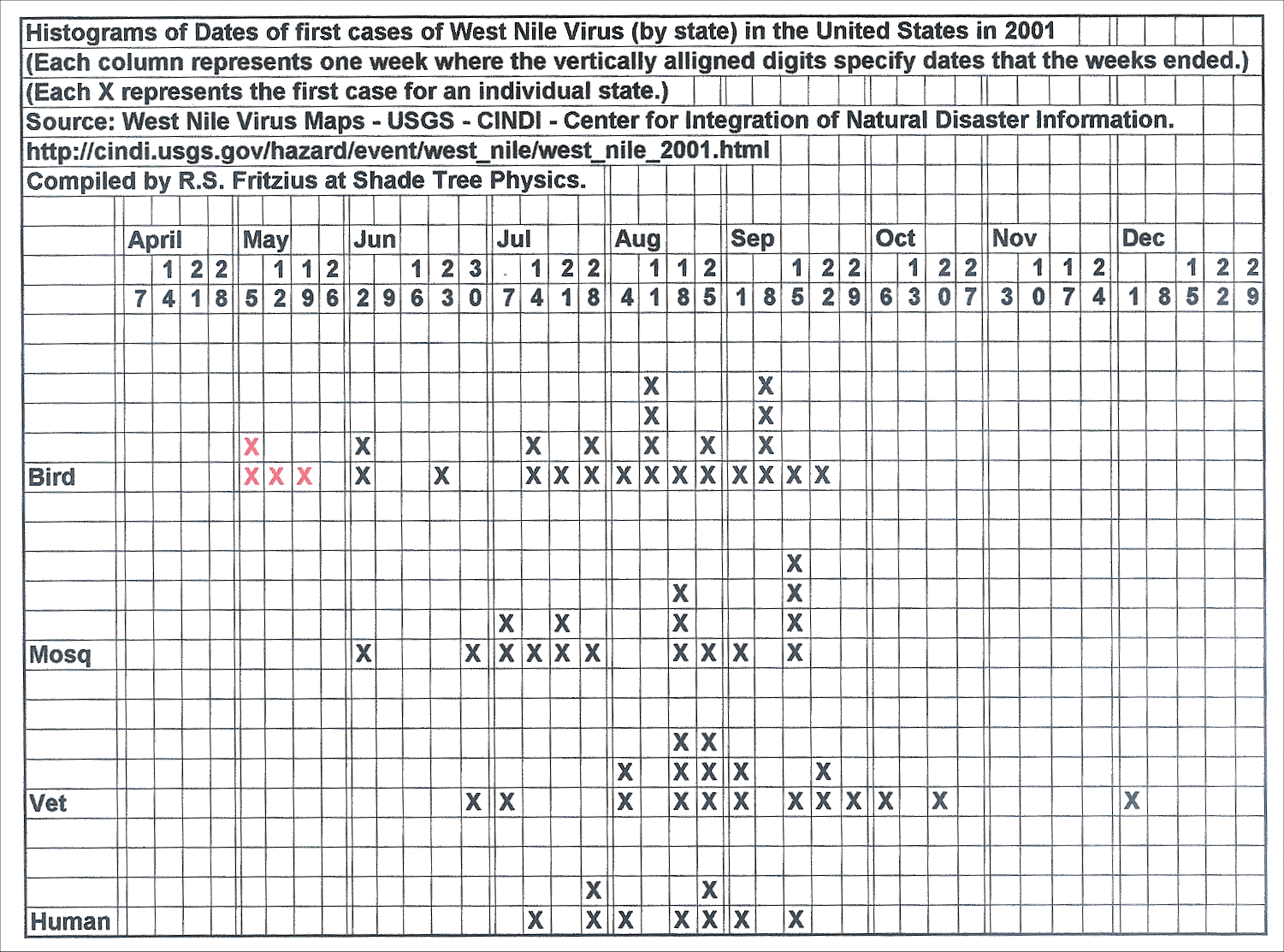
Bird cases of WNV, by week in 2001, for Maryland and New York (CINDI info) were available at www.riverdeep.net at http://www.riverdeep.net/current/2001/09/bar_graphs.jhtml . Notice the month of May cases which occurred in the 2 weeks to 2 months window following the March 30, 2001 Venus inferior conjunction.
Click on the links below the insert to see GIF animations showing the months when each U.S. state had its first bird case of West Nile Virus. [Click on back arrow, upper left corner, to return.]

2001 2002
References
(2) Tsai, T.F., Popovici, F., Cernescu, C., Campbell, G.L., Nedelcu, N.I., Lancet, 352(9130): 767-71 (1998).
(3) [PDF] Timeline of Key Dates and Events in the West Nile Virus Outbreak, 1999.
(4) West Nile Fever-a Reemerging Mosquito-Borne Viral Disease in Europe - Zdenek Hubálek and Jirí Halouzka, Academy of Sciences, Brno, Czech Republic. Published in CDC's - Emerging Infectious Diseases online Journal..
Recommended Reading
Robins Provide Clues in Tracking West Nile Virus - Jeff Brawn
"West Nile Fever: A Medical Detective Story," Bio Bulletin, Discusses West Nile Virus problems which sarted in June 1999 in New York City. This is an abstract only. URL was http://www.oer commons.org/courses/west-nile-fever-a-medical-detective-story].
West Nile Virus and Birds - American Bird Conservancy Position Statement
URL was http://www.abcbirds.org/conservationissues/threats/disease/wnv_position.html
Contact Robert Fritzius at
fritzius@bellsouth.net
Home |
Up one level |
Prev |
Next
Top